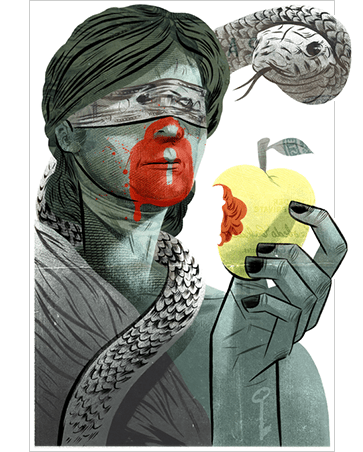Bitcoin is a digital currency created in 2009 by Satoshi Nakamoto. It is also the name of the open source software he designed that uses it, and the peer-to-peer network that it forms. Unlike most currencies, bitcoin does not rely on a central issuer, like a bank or government.Bitcoin uses a distributed database across a peer-to-peer computer network to record transactions, and uses cryptography to provide basic security functions, such as ensuring that bitcoins can only be spent once, and only by the person who owns them.
Bitcoin’s design allows for anonymous ownership and transfers of value. Bitcoins can be saved on a personal computer in the form of a wallet file or kept with a third party wallet service, and in either case Bitcoins can be sent over the Internet to anyone with a Bitcoin address. Bitcoin’s peer-to-peer topology and lack of central administration make it impossible for any government or other authority to change the value of bitcoins or induce inflation by producing more of them.
read more »
Bitcoin
Amero
The North American Currency Union is a theoretical economic and monetary union of three North American countries: Canada, the United States and Mexico. The hypothetical currency for the union is most often referred to as the amero. Conspiracy theorists contend that the governments of the United States, Canada, and Mexico are already taking steps to implement such a currency, as part of a ‘North American Union (NAU).’
In 2007, rumors and conspiracy theories began circulating across the Internet regarding alleged United States Treasury-issued amero coins. The inspiration behind these rumors may have been the posting of images of medallions created by coin designer Daniel Carr. Carr, who designed the New York and Rhode Island 2001 statehood quarters, sells medals and tokens of his own design on his commercial website, ‘Designs Computed.’ Among his designs are a series of gold, silver and copper fantasy issues of amero coins ranging in denomination from one to one thousand.
American Rule
In the field of law and economics, the American rule is a rule controlling assessment of attorneys’ fees arising out of litigation. The American rule provides that each party is responsible for paying its own attorney’s fees, unless specified otherwise by statute or contract. It contrasts with the English rule, under which the losing party pays the prevailing party’s attorneys’ fees. The rationale for the American rule is that people should not be discouraged from seeking redress for perceived wrongs in court or from trying to extend coverage of the law. The rationale continues that society would suffer if a person was unwilling to pursue a meritorious claim merely because that person would have to pay the defendant’s expenses if they lost.
The American rule is merely a default rule, not the blanket rule in the United States. Numerous statutes at both the federal and state levels allow the winner to recover reasonable attorney’s fees, and there are two major exceptions in federal case law as well. Many states also have exceptions to the American rule in both statutes and case law. For example, in California, the Consumers Legal Remedies Act allows plaintiffs to recover attorney’s fees, and in insurance bad faith cases, a policyholder may be able to recover attorney’s fees as a separate component of damages.
Blue Velvet
Blue Velvet is a 1986 American mystery film written and directed by David Lynch. The movie exhibits elements of both film noir and surrealism. The film features Kyle MacLachlan, Isabella Rossellini, Dennis Hopper, and Laura Dern. The title is taken from the 1963 Bobby Vinton song of the same name.
Although initially detested by some mainstream critics, the film is now widely acclaimed, and earned Lynch his second Academy Award nomination for Best Director. As an example of a director casting against the norm, Blue Velvet is also noted for re-launching Hopper’s career and for providing Rossellini with a dramatic outlet beyond the work as a fashion model and a cosmetics spokeswoman for which she had until then been known.
read more »
Porno Chic
The Golden Age of Porn or porno chic refers to a period in the history of pornography, approximately from the late-1960s to the early-to-mid-1980s that is idealized as a time where difficult to treat STDs had not achieved wide public notice. This freedom was ostensibly reflected in the pornography industry, with adult movies and adult magazines approaching the mainstream and becoming increasingly visible.
The golden age was also typified by interactions with the contemporaneous second wave of feminism. These were radical and cultural feminists which, along with the Christian right, attacked pornography, while other feminists were more concerned with ideas of sexual liberation and freedom from government intrusion into the growing industry.
read more »
Deep Throat
Deep Throat is a 1972 American pornographic starring Linda Lovelace (Linda Susan Boreman). One of the first pornographic films to feature a plot, character development and relatively high production standards, Deep Throat earned mainstream attention and launched the ‘porn chic’ trend despite the film being banned in some regions and the subject of obscenity trials.
The 61-minute movie is intended to be humorous, with highly tongue-in-cheek dialogue and songs; fireworks going off and bells ringing during Lovelace’s orgasms. The film’s popularity helped launch a brief period of upper-middle class interest in explicit pornography referred to by Ralph Blumenthal of The New York Times as ‘porno chic.’ Several mainstream celebrities admitted to having seen Deep Throat, including Martin Scorsese, Truman Capote, Jack Nicholson and Johnny Carson.
read more »
Canon
In the context of a work of fiction, the term canon denotes the material accepted as ‘official,’ in a fictional universe’s fan base. It is often contrasted with, or used as the basis for, works of fan fiction, which are not considered canonical. It is used in two slightly different meanings: first, it refers to the overall set of storylines, premises, settings, and characters offered by the source media text. In this sense, canon is the original work from which the fan fiction author borrows. Secondly, it is used as a descriptor of specific incidents, relationships, or story arcs that take place within the overall canon; thus certain incidents or relationships may be described as being canon or not.
The use of the word ‘canon’ in reference to a set of texts derives from Biblical canon, the set of books regarded as scripture. The term was first used in the context of fiction to refer to the Sherlock Holmes stories and novels, written by Sir Arthur Conan Doyle, to distinguish those works from subsequent pastiches by other authors. It has subsequently been applied to many media franchises. Among these are science fiction franchises such as Star Trek, Star Wars, and Doctor Who, in which many stories have been told in different media, some of which contradict or appear to contradict each other.
Regulatory Capture
In economics, regulatory capture occurs when a state regulatory agency created to act in the public interest instead advances the commercial or special interests that dominate the industry or sector it is charged with regulating. Regulatory capture is a form of government failure, as it can act as an encouragement for large firms to produce negative externalities (a cost or benefit incurred by a party who did not agree to the action causing the cost or benefit). The agencies are called ‘captured agencies.’
In the aftermath of the 2010 Deepwater Horizon oil spill, the Minerals Management Service (MMS), which had had regulatory responsibility for offshore oil drilling, was widely cited as an example of regulatory capture. The MMS is now known as the Bureau of Ocean Energy Management, Regulation and Enforcement (BOEMRE).
Chupacabra
The chupacabra (literally ‘goat sucker’) is a legendary cryptid rumored to inhabit parts of the Americas. The name comes from the animal’s reported habit of attacking and drinking the blood of livestock, especially goats.
The most common description of chupacabras is a reptile-like being, appearing to have leathery or scaly greenish-gray skin and sharp spines or quills running down its back. Approximately 3 to 4 feet (1 to 1.2 m) high, it stands and hops in a similar fashion to a kangaroo.
Tartanry
Tartanry [tahr-tn-ree] is a word used to describe the kitsch elements of Scottish culture that have been overemphasized or superimposed on the country first by the emergent Scottish tourist industry in the 18th and 19th centuries, and later by an American film industry. The earliest use of the word ‘tartanry’ itself is said to have been in 1976.
It refers to often misrepresented or invented aspects of Scotland such as clan tartans, kilts, bagpipes, Scottish Gaelic and Highland culture more generally.
Tartan
Tartan [tahr-tn] is a pattern consisting of criss-crossed horizontal and vertical bands in multiple colors that originated in Scotland. Scottish kilts almost always have tartan patterns. Tartan is also known as ‘plaid’ in North America, but in Scotland, a plaid is a tartan cloth slung over the shoulder, or a blanket. The Dress Act of 1746 attempted to bring the warrior clans under government control by banning the tartan and other aspects of Gaelic culture. When the law was repealed in 1782, it was no longer ordinary Highland dress, but was adopted instead as the symbolic national dress of Scotland. It is generally stated that the most popular tartans today are the Black Watch (also known as Old Campbell, Grant Hunting, Universal, Government) and Royal Stewart.
Tartan is made with alternating bands of colored (pre-dyed) threads woven as both warp and weft at right angles to each other. The weft is woven in a simple twill, two over – two under the warp, advancing one thread each pass. This forms visible diagonal lines where different colors cross, which give the appearance of new colors blended from the original ones. The resulting blocks of color repeat vertically and horizontally in a distinctive pattern of squares and lines known as a sett.
Warp
In weaving cloth, the warp is the set of lengthwise yarns that are held in tension on a frame or loom. The yarn that is inserted over-and-under the warp threads is called the weft, woof, or filler. Each individual warp thread in a fabric is called a warp end or end. Warp means ‘that which is thrown across in Old English.’ Because the warp is held under extreme tension during the entire process of weaving, warp yarn must be strong.
Traditional fibers for warping are wool, linen and silk. With the improvements in spinning technology during the Industrial Revolution, it became possible to make cotton yarn of sufficient strength to be used as the warp in mechanized weaving. Later, artificial or man-made fibers such as nylon or rayon were employed.















